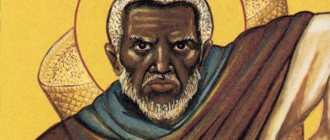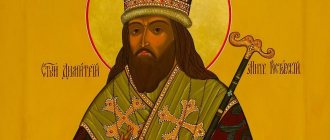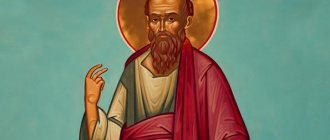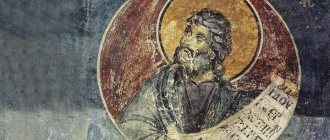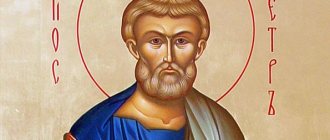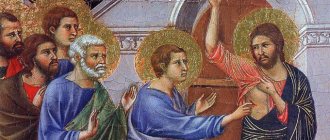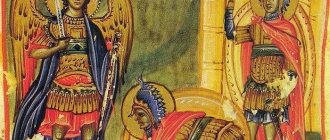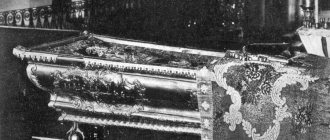One of the central events of the Old Testament is the story of Moses, the salvation of the Jewish people from the power of the Egyptian Pharaoh. Many skeptics are looking for historical evidence of the events that took place, since in the biblical account there were many miracles performed on the way to the Promised Land. However, be that as it may, this story is quite entertaining and tells about the incredible liberation and resettlement of an entire people.
Aaron - descendant of Levi
Aaron is the brother and assistant of the prophet Moses. Translated from Greek, his name means “high”, “mountain of light”, “teacher”. It is known in the East as an analogue of the popular name Harun.
Aaron in the Kyiv Psalter 1397. The High Priest Aaron is the brother of the prophet Moses. Aaron is three years older than Moses
The righteous man was born in 1574 in Egypt, where the Israeli people were in Egyptian captivity. He is a descendant of Levi. His father is Amram and his mother is Jochebed.
Aaron is three years older than his brother the prophet Moses, and younger than his sister Miriam.
Aaron was 3 years older than the prophet Moses.
The brother of the prophet Moses is famous for becoming the first Old Testament high priest and founding a line of Jewish priests, who became his children and descendants.
He married Elizabeth, daughter of Amminadab and sister of Naason. She comes from the tribe of Judah.
His four sons were named Abihu, Nadab, Ithamara and Eleazar. Only two of them survived. The rest were struck by the Lord for violating priestly rules - they were swallowed up by a crack in the ground.
Return of Moses to Egypt. Ten Plagues
The history of the prophet Moses, as a herald of God's will, began on the day when he appeared before the Pharaoh, who ruled at that time in Egypt. This was a different ruler, not the one from whom Moses fled at one time. Of course, Pharaoh refused the demand to release the Israeli people, and even increased the labor obligation for his slaves.
Moses and Ramses, whose history is more obscure than researchers would like, clashed in a confrontation. The prophet did not accept the first defeat; he came to the ruler several more times and ultimately said that God’s punishment would fall on the Egyptian land. And so it happened. By the will of God, ten plagues occurred that fell on Egypt and its inhabitants. After each of them, the ruler called on his sorcerers, but they found Moses’ magic more skillful. After each misfortune, Pharaoh agreed to let the people of Israel go, but each time he changed his mind. Only after the tenth did Jewish slaves become free.
Of course, the story of Moses did not end there. The Prophet still had years of travel ahead of him, as well as confrontation with the unbelief of his fellow tribesmen, until they all reached the Promised Land.
Aaron's life is described in the Torah and Old Testament
In the Bible, in the Old Testament, Aaron is given a secondary role. The main character everywhere is his brother, the prophet Moses.
At the same time, he actively participated in all events related to the liberation of the Israeli people from Egyptian captivity, performed miracles with them and participated in sending down some of the Egyptian plagues on Egypt.
In addition, Aaron was the first biblical priest and all his descendants became priests of Israel.
Tabernacle. Manuel Panselin. Fresco of the Church of the Assumption of the Virgin Mary in Protata. Athos. Beginning of the 14th century
Information about Aaron's youth has not been preserved, but from the story about Moses' youth it is known that the prophet was taken up to be raised at the court of Pharaoh as the adopted son of his daughter.
His elder brother at that time was on the eastern outskirts of Egypt among the Israelis languishing in captivity.
Naturally, he did not receive a good education, but at the same time he was distinguished by his eloquence.
Moses, on the contrary, was tongue-tied and therefore refused to fulfill the Lord’s order to free the people of Israel from Egyptian captivity.
Video by Aaron. Lecture. At 5 minutes 22 seconds it says that Aaron was always close to Moses.
To motivate Moses to do his will, God pointed to Aaron and told Moses that he would speak for him before Pharaoh and the Egyptian people. That's why he's called God
"...by the mouth of Moses and his prophet."
(Exodus 4:16, Exodus 7:1)
It should be noted that Moses, despite his tongue-tiedness, always remained a central figure and always spoke to the people independently.
Background and birth of Moses
The birth of the future prophet was initially shrouded in mystery. Almost the only source of information about Moses was the biblical scriptures, since there is no direct historical evidence, there is only indirect evidence. In the year of the prophet’s birth, the ruling Pharaoh Ramses II ordered all newborn children to be drowned in the Nile, since, despite the hard work and oppression of the Jews, they continued to be fruitful and multiply. Pharaoh was afraid that one day they might side with his enemies.
That is why Moses’ mother hid him from everyone for the first three months. When this was no longer possible, she tarred the basket and placed her child there. Together with her eldest daughter, she took her to the river and left Mariam to see what happened next.
God wanted Moses and Ramses to meet. History, as mentioned above, is silent about the details. The basket was picked up by the pharaoh's daughter and brought to the palace. According to another version (which some historians adhere to), Moses belonged to the royal family and was the son of that very daughter of Pharaoh.
Be that as it may, the future prophet ended up in the palace. Miriam, who had observed whoever lifted the basket, offered Moses' own mother as a nurse. So the son returned to the family for a while.
Aaron's rod struck the Egyptian pharaoh, and he released the Jews from captivity
When Aaron was 83 years old, he met with Moses in the desert to speak to the elders of the Egyptians and to Pharaoh.
Such a speech was required in order to ask them to release the Jews from Egyptian captivity.
They were to serve God in the Jerusalem Temple. It was at this time that the Old Testament prophet of Moses performed his first miracle.
Aaron. Painting in the apse of the Chapel of Prophets and Saints of the VMC Monastery. Catherine in Sinai. Ser. XV century With the help of his rod, the high priest Aaron performed a miracle: he turned him into a snake
The fact is that Pharaoh did not believe the words of Moses and Aaron and refused to let the Jews go to Israel. In order to show him the power of the Lord, Aaron turned his rod into a snake.
Egyptian sorcerers performed the same miracle and the Lord, proving his omnipotence, through Aaron ordered him to absorb the fakirs' rods. This happened and caused Pharaoh to fear the power of God.
Aaron's Rod
with his help the first three plagues were brought upon Egypt
Subsequently, with the help of a rod, the high priest brought the first three plagues on the Egyptians.
Next, Moses himself punished them, and the rod could perform miracles only in his hands. An example of this is the cutting of the Red Sea.
At the same time, Aaron supported the hands of Moses along with Hur during the prophet’s prayer during the battle of the Israelites with the Amalekites, that is, he remained his closest assistant.
When Moses lowered his hands, the Israelites began to lose, but if the prayer's hands were raised, Israel won.
Lyrics
A prayer and a canon are dedicated to the Prophet Moses.
Prayer
“Oh, most holy Moses, prophet of God! Hear our prayers and come to our aid, protect us from our enemies, from troubles and grief, from evil and dishonor. Don't leave us unattended. Pray to the Lord in Heaven for us and ask for protection for us and the souls of our sinners. May your name be glorified, may Orthodox people praise you and bow before you! Protect our souls and do not let us go astray. From now on and forever and ever. Amen".
Canon
After Pharaoh released the Jews to Israel, he ordered Aaron to be ordained high priest.
When Moses concluded the Covenant with the Lord, he was not present at the location of the Deity, but accompanied him along with 70 elders and his sons Nadab and Abihu while ascending Mount Sinai.
The Lord allowed only Joshua and Moses himself there. After the prophet ascended the mountain again, he appointed Aaron and Hur to administer judgment and oversee the people.
Mount Sinai. The prophet Moses climbed onto it to receive the Tablets of the Covenant from the Lord. He entrusted Aaron with overseeing the people and administering justice.
During the absence of Moses, who was on Mount Sinai in order to receive the tablets of the Covenant from the Lord, Aaron offended the Lord and violated his commandment “Thou shalt not make for theeself an idol.”
Yielding to the requests of the people, he made a golden calf. The fact is that the Israelites wanted to see a visible image of God, who freed them from Egyptian captivity.
After this, a pestilence began to rage among the people: this is how the Lord punished those who transgressed His Covenant. Because of Moses' intercession with God, he did not affect Aaron.
Adoration of the Golden Calf, Nicolas Poussin, 1633
Further, over the course of 40 days, the Lord gave Moses several instructions, among which was the instruction to call the tribe of Levi to priestly service.
Moses personally anointed Aaron as high priest.
He was dressed in priestly robes and Moses told him of his duties.
Moreover, they, as well as the rights of the priests and the procedure for performing the sacrifice, were established by the Lord himself; Archimandrite Nikephoros claims that this happened in 1490 BC.
That is why deviation from these rules was severely punished.
On the very day of dedication, Naddab and Abihu performed sacrifices in a manner prohibited by the Lord.
“... They brought strange fire before the Lord, which He did not command them.”
(Lev. 10.1)
For this they were burned by God's fire, while Aaron silently accepted such punishment, which was required to show that priests should take their duties seriously and carefully.
The Israelite People's Forty-Year Desert Journey
The Jewish people stood near Mount Sinai for about a year. Then the Lord gave a sign that we needed to move on. The story of Moses as a prophet continued. He continued to bear the burden of mediating between his people and the Lord. For forty years they wandered through the desert, sometimes living for a long time in places where conditions were more favorable. The Israelites gradually became zealous fulfillers of the covenants that the Lord gave them.
Of course, there were outrages. Not everyone was comfortable with such long journeys. However, as the story of Moses from the Bible testifies, the people of Israel still reached the Promised Land. However, the prophet himself never reached it. Moses had a revelation that another leader would lead them further. He died at the age of 120, but no one ever found out where it happened, since his death was a secret.
Moses Confirmed Priesthood Advantages of the Tribe of Levi
When it was the second year of wandering through the Egyptian desert, the high priest spoke out against Moses.
He joined the prophet's sister Miriam, who argued that the prophet had a special position before God. In addition, they reproached Moses, who took an Ethiopian wife as his wife.
Most likely, Miriam was the initiator of the speech, because it was not for nothing that the Lord punished her with leprosy. Aaron has to ask the Lord to heal her.
He himself repented of his sin and did not suffer from illness because the priesthood protected him.
Aaron with a blossoming rod, miniature from Speculum humanae salvationis, 1450. In order to reaffirm Aaron's high priesthood, the Lord caused his rod to bloom
At the same time, the uprising of Korah, Dathan and Abiron occurred. The rebels opposed Moses, and also disputed the right to the priesthood for the descendants of Aaron. The rioters died.
They were swallowed up by an opening abyss, and the people blamed Moses and Aaron for this. To stop the unrest among the Jews, the Lord sent a pestilence on them. Aaron had to make a sacrifice to stop it.
After this event, the Lord once again confirms the high priesthood of Aaron. He performed a miracle by causing the rod of Levi, which bore the name of Aaron, to bloom.
Historical facts confirming biblical events
Moses, whose life story we know only from biblical accounts, is a significant figure. However, is there official data that confirms his existence as a historical figure? Some consider all this just a beautiful legend that was invented.
However, some historians are still inclined to believe that Moses is a historical figure. This is evidenced by some information contained in the biblical story (slaves in Egypt, the birth of Moses). Thus, we can say that this is far from a fictional story, and all these miracles actually happened in those distant times.
It should be noted that today this event has been depicted more than once in cinema, and cartoons have also been created. They tell about heroes such as Moses and Ramses, whose history is little described in the Bible. Particular attention in the cinema is paid to the miracles that happened during their journey. Be that as it may, all these films and cartoons educate and instill morality in the younger generation. They are also useful for adults, especially those who have lost faith in miracles.
Aaron and Moses did not enter the promised land
Aaron and Moses did not enter the promised land. The fact is that the prophet showed impatience in Kadesh or Merib.
This happened while the Israelites were wandering in the desert for the last year. This is a deserted and lifeless area. There was no water or plants here.
Moses cutting out water from a rock. The author belongs to the School of Raphael. Having disobeyed the Lord and struck the rock twice with a rod to get water from it, Moses lost the opportunity to enter the Promised Land
Since the people began to grumble, Moses decided to draw water from the rock. At the same time, he asked the Lord for help, and he told him to command the rock so that water would begin to flow from it.
The Prophet disobeyed the Lord and used his staff. He hit it twice on the rock. Thus, he used the Grace of God without His permission.
As punishment for Aaron, who repeatedly disobeyed God, and Moses, who succumbed to his persuasion and extracted water from a rock with the help of a rod, the Lord forbade him to enter the promised land, where they had devoured the people of Israel.
“Because you did not believe Me, to demonstrate My holiness in the sight of the children of Israel, you will not bring this people into the land that I am giving them.”
(Num. 20:8-12)
For disobeying God, Aaron lost his priesthood.
As for Aaron, the Lord punished him separately: He commanded Moses to ascend Mount Hor with Aaron and his son Eleazar.
Here the Old Testament high priest lost his priesthood. Moses took off his priest's robe and gave it to his son.
Aerial view of Aaron's grave. Mount Or, Jordan. According to one version, the high priest Aaron died here
There are two versions of Aaron's death.
The first says that he died on Mount Hor. At this moment his age was 123 years. The people of Israel cried for him for 30 days.
30 days
for so many days the people of Israel cried over the death of Aaron
The second version says that the righteous man died in Moser, where he was buried. There are only seven day treks between the peak and the city.
The covenants that Moses received on Mount Sinai
The next stop for the Jewish people was Mount Moses. The story from the Bible tells that on this path the fugitives saw many miracles (manna from heaven, springs of spring water appearing) and became stronger in their faith. Ultimately, after a three-month journey, the Israelites came to Mount Sinai.
Leaving the people at its foot, Moses himself climbed to the top for the instructions of the Lord. There a dialogue took place between the Father of All and his prophet. As a result of all this, the Ten Commandments were received, which became basic for the people of Israel, which became the basis of legislation. Commandments were also received that covered civil and religious life. All this was written down in the Book of the Covenant.
Commemoration of the High Priest in Orthodoxy
In local Orthodox Churches the righteous high priest is not separately venerated. The commemoration of his name occurs together with the names of other Old Testament righteous people.
It is usually found in the services of the Forefather and Father Weeks on the eve of the Nativity of Christ.
These are the last two weeks, that is, Sundays of the Nativity Fast. They are dedicated to the memories of the Savior’s ancestors and all the Old Testament righteous people who awaited His coming.
July 20
Aaron Memorial Day
In addition, the righteous man is also commemorated along with the prophet Moses in the first week of Lent.
Most old month books talk about the day of Aaron, mentioning July 20th.
Right Aaron. Fragment of a Russian icon, from the iconostasis of the Nativity Cathedral of the Ferapontov Monastery. 1502 Usually the righteous Aaron is depicted as an old man with a long pine tree holding a scroll
As for the icons of the prophet, they are usually depicted in a number of scenes of the Exodus. One of these images has been preserved in the Dura-Europos synagogue in Syria.
The painting dates back to 245-250 AD and depicts an old man.
He is dressed in the robes of the high priest: ephod, breastplate, subdir, and miter - headdress. The righteous man is located inside the Temple in which the Ark of the Covenant was kept.
In the early monuments of the fine arts of Byzantium, the image of Aaron can be seen in the form of a young man in ancient clothes. A stable image of him developed in icon painting in the 9th-11th centuries.
It is characterized by the presence of an image of a gray-haired old man. He has a long beard and holds a rod, censer or casket in his hands. He is dressed in the clothes of a priest.
Holy Forefather Aaron, the gate of the iconostasis. Assumption Church in the Demyanovo estate. Often on icons of the forefather Aaron he is depicted with a staff and dressed in priestly robes
Sometimes you can see images that describe certain events from the life of the prophet.
For example, a common plot is in which Aaron's rod turns into a snake. In addition, images of the high priest together with Moses are frequent. On iconostas he is usually depicted in a prophetic row.
Worship of Aaron in Judaism and Islam
In addition to the Christian church, Aaron is revered in Judaism and Islam. The Jews believe that the high priest is the harbinger of the coming of the Messiah.
In addition, the writings of the rabbis emphasize that Moses' brother had a very meek disposition. He was considered a peacemaker, and for this the Lord made him high priest.
Jewish high priest. 19th century illustration. The Lord made Aaron high priest through the prophet Moses for his meek and peaceful disposition.
Jews and early Christians believed that Aaron's death and punishment for his misdeeds were due to original sin.
That is, a prophet cannot be called sinful. The “Serpent” tempted him to disobey God’s Will. The Israelite high priests grieved over the death more than over the death of Moses.
Harun ibn Imran
This is what the Muslims called Aaron, which means the elder brother of Moussa or Moses.
Muslims call him Harun ibn Imran, that is, the elder brother of Moussa or Moses. The Qur'an follows the tradition of depicting Aaron as the helper of the tongue-tied Moses.
At the same time, Islam does not recognize the fact that he created the golden calf for worship. All the blame for this act is placed on the unknown Samaritan.
Aaron's grave is revered by representatives of three religions
Aaron's grave refers to Mount Jabal Harun or Mount Aaron. It is located five kilometers west of the city of Petra Nabet, in Jordan.
Josephus, the famous Roman historian, believed that it was identical to the biblical Mount Or, where the righteous man died at the age of 123.
Arabs still revere this place, and Jews and Christian pilgrims also come to it.
A 14th-century Islamic shrine over Aaron's tomb on top of Mount Aaron (Jabal Harun). Nowadays, on the top of Mount Hor, where the righteous Aaron died, there is an Islamic sanctuary
In 1999, archaeological excavations were carried out at the top of the mountain under the leadership of Finnish archaeologist Jaaako Fresin.
The remains of a Byzantine basilica were discovered on the existing ruins of the church complex. It is mentioned by a papyrus dating back to the 6th century.
It says that this is “the house of Aaron.” They also found the remains of a chapel, on the pedestal of which there is a Greek inscription “ΑΑΡΩΝ”.
In addition, there is a mosque on the mountain, which was most likely rebuilt from a Christian temple during the reign of the Byzantine emperor Justinian.
By leaving a comment, you accept the user agreement
